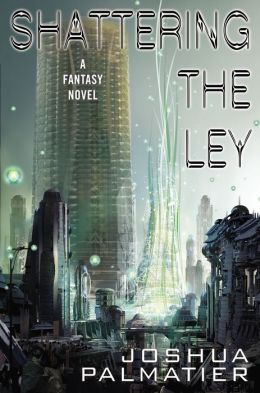Joshua Palmatier has had a rather ragged career to date. After his first trilogy from DAW Books—The Skewed Throne (2006), The Cracked Throne (2007), and The Vacant Throne (2009) — he published two novels under the name of Benjamin Tate, The Well of Sorrows (2011) and Leaves of Flame (2012). Shattering the Ley marks a return to his Palmatier name and, it appears, lays the groundwork to begin a new series.
Shattering the Ley stands apart from the majority of second-world fantasy by having a distinctly modern cast to its world-building.
The city of Erenthrall is fuelled by the magic of the ley lines: ley magic powers its ovens and its factories, public transport and flying barges. This harnessing of magic is only possible because humans have altered the original flows of the ley lines: under the direction of Erenthrall’s Baron, ley magic “Wielders” created the Nexus and ley nodes throughout the city, to control and channel the power of the ley. Erenthrall and its associated subject cities enjoy a high standard of living, but the Baron is a tyrant whose rule is upheld by his vicious personal guard—the “Dogs”—and a cadre of bestial assassins, the “Hounds.” The Baron’s grip on the leylines of power is challenged by the ambitions of his vassals, and by a religiously-inspired group of dissidents, the Kormanley, who want to restore ley magic to its natural state.
But unfortunately, the novelty provided by Shattering the Ley’s modern cityscape—with universal schooling and a university, trams, and terrorists—doesn’t make up for its structural and narrative deficiencies. You’ll notice that while I’ve discussed the novel’s setting, I’ve yet to provide any description of what the book is about. That’s because, apart from “a bunch of things happening involving challenges to the Baron’s grip on power” and “things happening with ley magic,” I’m not actually sure. There’s no solid narrative through-line I can discern.
Shattering the Ley takes place over a period of approximately fifteen or sixteen years, with two significant jumps forward in time. There are three or four years between Part I and Part II (both relatively short sections of the narrative) and then a jump of twelve years between Part II and Part III (which is longer than Parts I and II put together). The cast of viewpoint characters is relatively large for a book of no more than five hundred pages, and many of their scenes exist for little purpose other than expositing, or so that characters can talk about what they don’t know, or what they plan to accomplish.
The narrative wanders. It staggers, to be blunt, a bit like a stag party heading for the train station on the morning after the big match. There are threads of story that veer into dead-end alleys and hints of foreshadowing that ultimately amount to nothing. Character development is next to non-existent: all of the players finish the story pretty much unchanged from the people they were when it began—and considering we first meet one of them as a twelve-year-old, that’s quite an achievement.
A writer can get away with a meandering narrative if the story demonstrates strong thematic coherence, together with compelling characters and/or pretty prose. Conversely, they can get away without thematic coherence, pretty prose, and/or compelling characters if the story is brief and brisk and filled with explosions and delightful popcorn-for-the-brain. While Shattering the Ley has several explosions, it doesn’t sustain a brisk narrative tension over the long haul, and across its various parts and movements and perspectives, it doesn’t have the kind of unity of theme or purpose that makes a whole greater than the sum of its bits and pieces.
In the hands of a better writer, the scattered nature of Shattering the Ley’s range of moving parts, the way in which alleys of perspective wander off and never return to a central through-line, the way in which ley magic is gradually breaking down in Erenthrall just as some of our main characters have lives in which relationships die or are severed or shattered, might come across as deliberate. A writer with more control over their prose and the structure of their narrative might have made these meanderings seem intentional: made them serve a theme where things fall apart and the centre cannot hold. In Shattering the Ley, I’m afraid, no such thematic lucidity holds sway.
Which makes this a passably readable book, but—alas!—not a very good one.
Shattering the Ley is available July 1st from DAW.
Liz Bourke is a cranky person who reads books. Her blog. Her Twitter.










